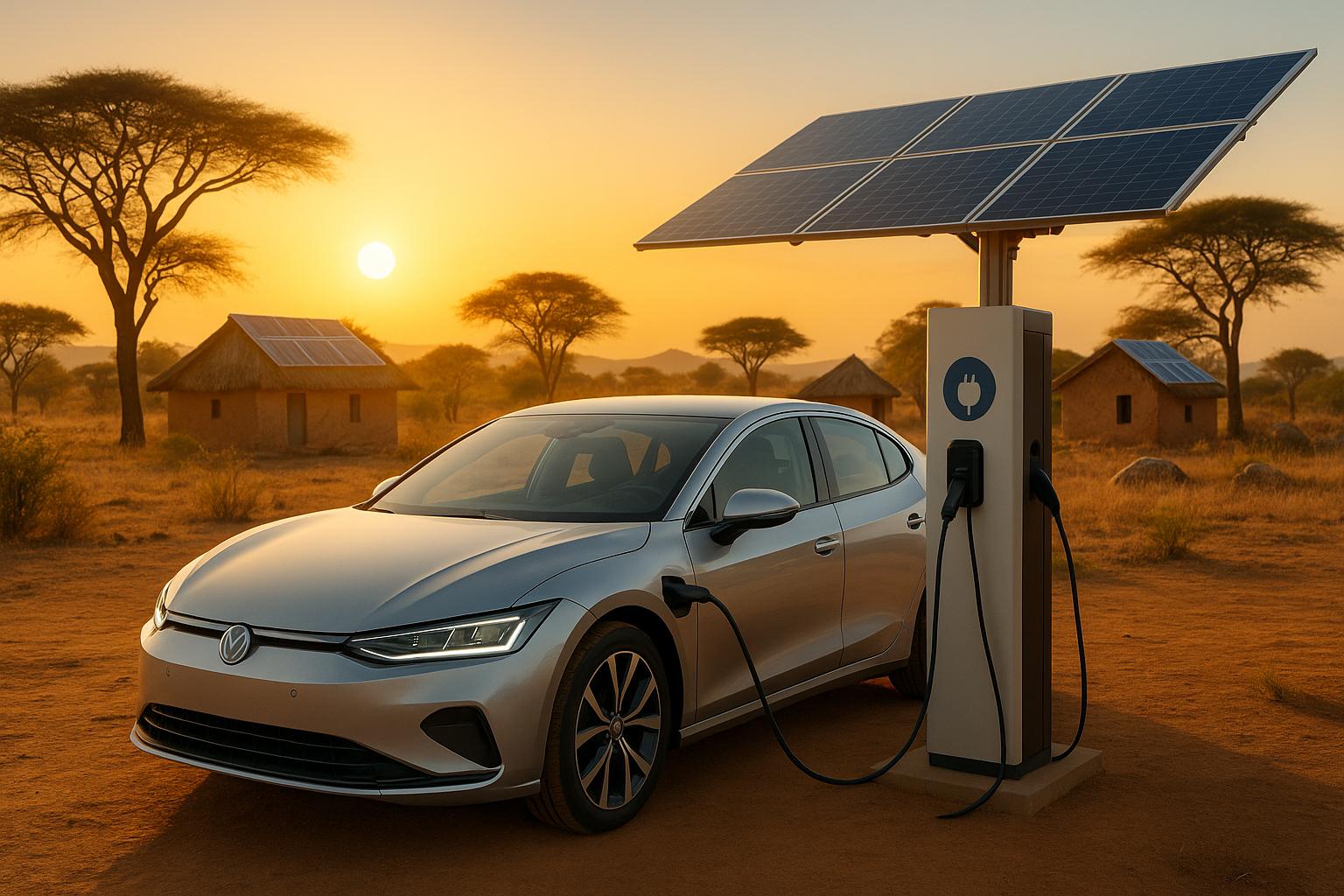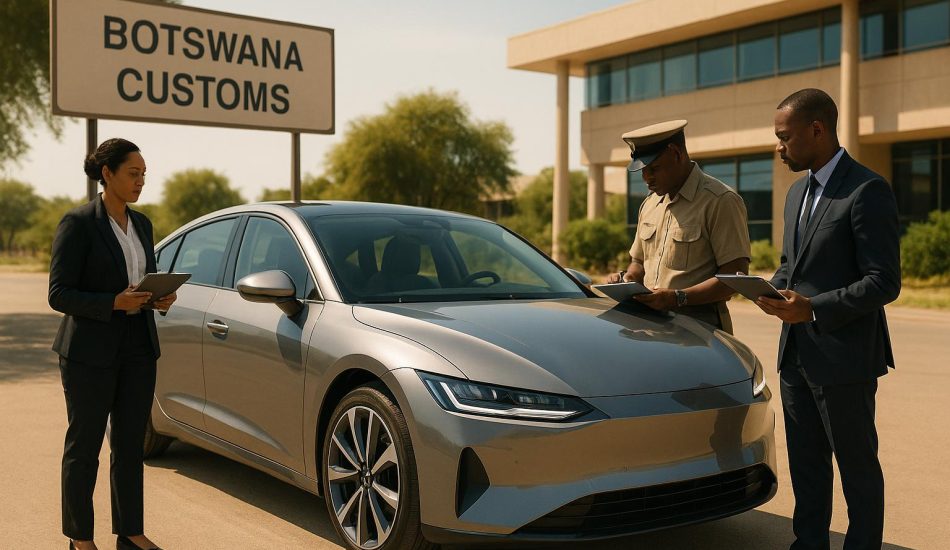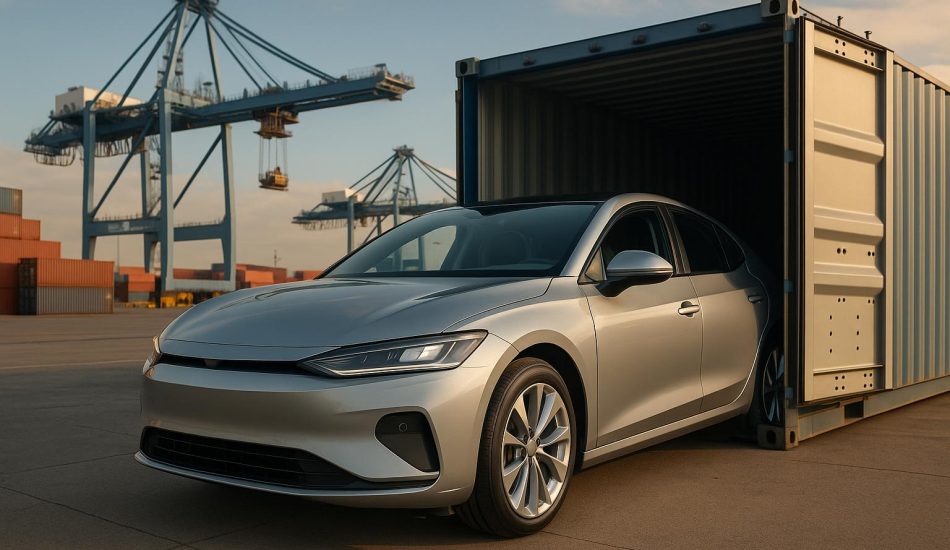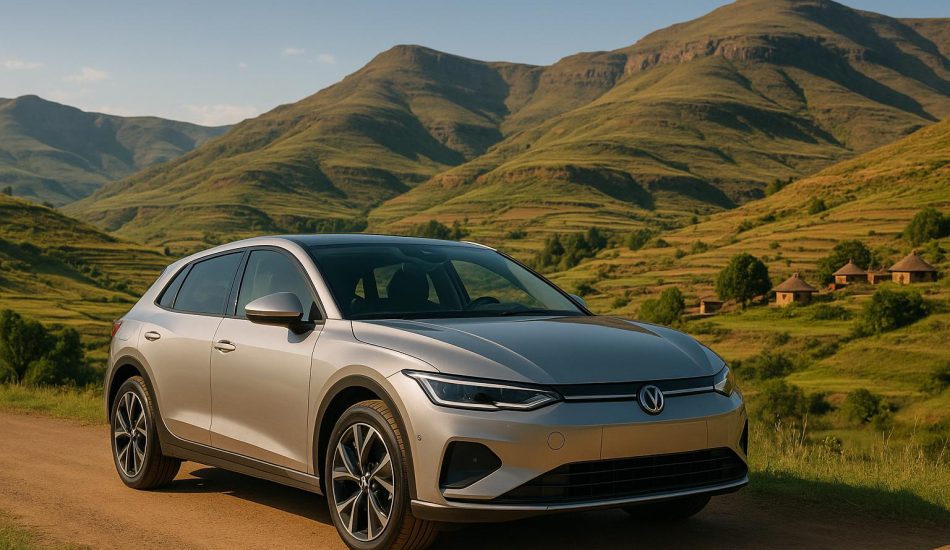
Think electric cars won’t work in Africa? Think again. Here’s the truth: Electric vehicles (EVs) are becoming more practical and accessible across the continent. From charging infrastructure to affordability, many common misconceptions are simply outdated.
Key Takeaways:
- Myth: EVs create more carbon emissions.
Fact: EVs produce fewer lifetime emissions than gasoline cars, even with fossil fuel-based grids. - Myth: EVs can’t drive far enough.
Fact: Modern EVs can travel over 350 miles per charge, with tools to plan long trips. - Myth: Africa lacks charging stations.
Fact: Public and private investments are rapidly expanding charging networks, including solar-powered options. - Myth: EVs are too expensive.
Fact: Affordable models start at $4,800, with lower operating costs over time. - Myth: EVs can’t handle rough roads.
Fact: EVs are built with durable features like skid plates and instant torque for tough terrains. - Myth: The EV push is suspicious.
Fact: EVs address urgent air pollution and economic challenges in Africa. - Myth: EVs don’t work for businesses.
Fact: Companies are saving money and reducing emissions with EV fleets.
Quick Overview:
| Myth | Reality |
|---|---|
| EVs create more emissions | EVs produce fewer lifetime emissions than gasoline cars. |
| EVs can’t drive far enough | Many EVs now exceed 350 miles per charge. |
| No charging stations in Africa | Charging networks are growing, with solar-powered stations emerging. |
| EVs cost too much | Models start at $4,800, with lower long-term costs. |
| EVs can’t handle rough roads | Modern EVs are designed for tough terrains with advanced features. |
| EV push is suspicious | EVs reduce air pollution and fuel dependency. |
| EVs don’t work for businesses | Businesses are cutting costs and emissions with EV fleets. |
EVs in Africa are not just possible – they’re practical. Whether you’re worried about range, cost, or infrastructure, the facts show that EVs are a viable solution for individuals and businesses alike.
Hot Topic | Electric car Myths | The Electric Mission
Myth 1: EVs Create More Carbon Emissions
Some believe that electric vehicles (EVs) generate more carbon emissions than gasoline cars. This idea often stems from concerns about battery production and electricity sources. However, research consistently shows that EVs produce far fewer emissions over their lifetime.
Comparing Total Emissions
When looking at total lifetime emissions, EVs consistently outperform gasoline vehicles. Even in regions heavily reliant on fossil fuels for electricity – such as India – medium-sized EVs registered in 2021 generated 19–34% fewer lifetime emissions compared to similar gasoline vehicles.
This improvement comes from advancements in manufacturing, battery production, operation, and recycling. As electrical grids increasingly incorporate renewable energy, these benefits will only grow.
Africa’s Push for Clean Energy
Africa is making strides in building cleaner charging infrastructure to support EVs. In South Africa’s Free State province, a $234 million solar-powered EV network is underway. By September 2025, the project aims to install 120 charging stations.
"This initiative promotes not only off-grid EV charging but also socio-economic benefits", said Thabo Meeko, Free State Minister.
"Solar charging offers a clean, zero-emission alternative to Eskom’s grid", explained Zero Carbon Charge (ZCC).
These solar-powered stations eliminate dependence on coal-fired electricity. The cost of charging stations varies based on their type:
| Charging Station Type | Cost Range | Primary Use Case |
|---|---|---|
| Fast Charging | $50,000 – $200,000+ | Highway corridors |
| Medium Charging | $10,000 – $50,000 | Urban centers |
| Slow Charging | $300 – $10,000 | Residential/Workplace |
This multi-tiered approach ensures that charging stations can be deployed strategically across various locations.
Myth 2: EVs Can’t Drive Far Enough
Modern EVs are more than capable of covering long distances. Back in 2011, early EVs could only travel between 63 and 94 miles per charge. Fast forward to today, and many models now boast ranges exceeding 350 miles on a single charge. For perspective, the average American drives just 37 miles per day. With a bit of planning, even long-distance trips are entirely manageable.
Current EV Range Stats
Today’s EVs showcase impressive range capabilities. Here are some standout models:
| Vehicle Model | Maximum Range |
|---|---|
| Lucid Air Dream Edition | 425 miles |
| Lucid Air Grand Touring | 413 miles |
| Mercedes EQS | 397 miles |
| Tesla Model S | 354 miles |
| Lucid Air Pure | 348 miles |
Planning Long-Distance EV Trips
For extended trips, a little preparation goes a long way, especially in areas where charging stations are still being built out. Tools like A Better Route Planner (ABRP) can help make the process seamless.
"ABRP creates a route for you based on your vehicle’s make and model, starting state of charge, and charging station preferences. It is a robust tool that every EV driver should have in their arsenal, especially since it is free."
Here are some tips for efficient EV travel:
- Start your trip with a 90-95% charge.
- Plan charging stops at hotels or accommodations where you can charge overnight.
- Drive at efficient speeds to stretch your range.
- Use fast chargers strategically, charging up to 80% to save time.
- Consider weather conditions, as they can impact battery performance.
Practical examples back this up. FedEx South Africa, for instance, uses Everlectric for their fleet. Additionally, Plug In America staff highlight the benefits of overnight charging: "Charging where you stay overnight lets you save time and money. Plus, it’s always great to wake up to a full charge.". With thoughtful planning, EVs are well-suited for both personal and commercial long-distance travel.
Myth 3: No Charging Stations in Africa
Africa’s charging infrastructure is growing quickly, driven by investments from both public and private sectors.
Public Charging Network Growth
The African EV charging market was valued at $31.93 million in 2022 and is expected to grow to $256.53 million by 2030. South Africa alone currently hosts around 316 public charging stations. Recent efforts highlight the progress:
- Audi-GridCars Partnership: In August 2022, Audi teamed up with GridCars to install 33 new charging stations in South Africa. These include 70 charge points, offering capacities from 22kW AC to 150kW DC ultra-fast charging.
- CHARGE Initiative: In November 2024, CHARGE launched its first off-grid, ultra-fast green EV charging station in Wolmaransstad. The station features six DC fast chargers capable of charging vehicles in about 25 minutes.
"The live 150kW (DC) public chargers initiated by Audi are the first for the South African market and will enable +/- 340km driving range in approximately 30 minutes." – Audi
In addition to public charging networks, personal charging solutions are shaping the EV landscape in Africa.
Personal Charging Options
Charging solutions for homes, workplaces, and public spaces provide flexibility, with costs ranging from $300 for slow chargers to $200,000 for fast chargers:
| Charging Type | Cost Range | Best Use Case |
|---|---|---|
| Slow Charging | $300 – $10,000 | Home/Office |
| Medium Charging | $10,000 – $50,000 | Workplace/Mall |
| Fast Charging | $50,000 – $200,000 | Highway/Urban Areas |
Solar-powered chargers are also gaining traction in areas with limited grid access. Companies like Zimi Charge are actively contributing to this expansion.
"We are excited to launch this new product in South Africa as it will help us address one of the biggest challenges facing electric vehicle owners when they are away from home." – Michael Maas, CEO of Zimi Charge
"It is clear that the development of a network of off-grid, renewably powered EV charging stations is the only way we will reduce transport emissions in the country." – Joubert Roux, Executive Chairman of CHARGE
Zimi Charge has plans to install 1,000 additional stations across South Africa by 2025. While home charging remains the most convenient for daily use, the growing public infrastructure is making longer trips more practical.
Myth 4: EVs Cost Too Much
Electric vehicles (EVs) may seem expensive at first glance, but the overall cost of owning one in Africa tells a different story. While the initial price tag can be higher, the savings on fueling and maintenance over time often make EVs a smart financial choice. Let’s take a closer look at affordable EV options and payment plans that challenge the idea of unaffordability.
Affordable EV Models and Financing Options
The African EV market now includes a range of budget-friendly models that make electric mobility more accessible. Here are some examples:
| Model | Price | Range |
|---|---|---|
| LINGBOX UNI | $4,800 | 120 miles |
| GEELY PANDA MINI BASE | $5,880 | 150 miles |
| BYD DOLPHIN ACTIVE | $11,800 | 190 miles |
| BYD QIN PLUS EV | $14,180 | 230 miles |
These models cater to a variety of budgets:
- Entry-Level: $4,800 to $8,300
- Mid-Range: $11,800 to $17,880
- Premium: $23,300 to $97,000
Flexible financing options, such as installment plans and loans, make it even easier for consumers to make the switch. Combined with lower running costs, these options are helping more people in Africa see EVs as a practical and affordable choice. The growing variety of models ensures there’s something for everyone, regardless of budget or lifestyle.
sbb-itb-99e19e3
Myth 5: EVs Can’t Handle Rough Roads
There’s a common belief that electric vehicles (EVs) aren’t built for tough terrains like those found in parts of Africa. However, today’s EVs are designed to tackle both city streets and rugged, unpaved roads with ease.
EV Build Quality
Modern EVs are built to endure challenging conditions, thanks to several key design features:
- Protected Battery Systems: Reinforced undercarriages and skid plates safeguard critical components from damage.
- Structural Stability: The low placement of the battery pack enhances stability and balance, even on uneven surfaces.
- Simpler Mechanics: With fewer moving parts than traditional vehicles, EVs are less likely to suffer mechanical failures and generally require less upkeep.
"We are surprised because we really pushed the car over the limits. The skid plate got its share, but no big holes or something, it is just scratched and a bit dented. But apart from a cracked windscreen, that’s the only thing. There was no maintenance done, we only refilled the windscreen washer fluid regularly. And some minor plastic body parts were replaced. But the core of the car is so strong! We didn’t have to do anything at all."
On top of their durable construction, EVs come with performance features that make them even more capable in off-road conditions.
EV Performance Features
Electric vehicles are equipped with advanced technologies that improve their performance on rough terrain:
| Feature | Benefit |
|---|---|
| Instant Torque | Delivers immediate power, providing better control on steep inclines. |
| Advanced Traction Control | Distributes power to individual wheels for superior grip. |
| Adjustable Ride Height | Allows up to 14.9 inches of ground clearance for tougher trails. |
| Water Protection | Sealed systems can handle water crossings up to 3 feet deep. |
"Out of the total 5,800 km, we drove over 600 km of trails. We encountered mud (it was the end of the rain season), stony paths, lots of sand and dust. But the car stood up to everything very well. Venturi has just proven that electrical technology can adapt to all terrains in Africa, thus opening up the path to new economic and environmental prospects on this continent."
These real-world examples prove that today’s EVs are more than capable of handling Africa’s varied and challenging road conditions, putting to rest the myth that they’re too fragile for rough roads.
Myth 6: EV Push is Suspicious
After addressing concerns about durability and performance, let’s tackle the skepticism surrounding the push for electric vehicles (EVs) in Africa.
Some critics question the motives behind Africa’s shift toward EVs, but the data tells a different story. The move is driven by urgent public health and economic needs. Transportation accounts for 24% of direct CO2 emissions globally, and air pollution is responsible for over four million deaths each year. Cleaner transportation isn’t just a trend – it’s a necessity.
EV Adoption Across Africa
Here’s a snapshot of how EV adoption is shaping up in select African countries:
| Country | EV Adoption Benefits | Current Status |
|---|---|---|
| Zimbabwe & Mozambique | – Strong renewable energy potential – Minimal grid upgrades required – Competitive power costs |
High potential with fewer barriers |
| Kenya | – Low grid emissions – Urban air quality challenges – High transport emissions |
Promising but requires grid improvements |
| Tunisia & Senegal | – Low transport emissions – High-emission power grids |
Lower priority for now |
Local Benefits of EV Adoption
Studies show that communities embracing zero-emission vehicles (ZEVs) experience tangible benefits. For example, a study found that as ZEV ownership increased from 1.4 to 14.6 vehicles per 1,000 people between 2013 and 2019, local air pollution decreased, leading to fewer emergency room visits.
"When we think about the actions related to climate change, often it’s on a global level, but the idea that changes being made at the local level can improve the health of your own community could be a powerful message to the public and to policy makers." – Erika Garcia, PhD, MPH
Africa’s EV Readiness
The continent’s readiness for EVs is a mix of progress and challenges:
- 28% of African countries have set national EV targets.
- 39% have legally binding EV incentives.
- 17% have installed at least 10 public charging stations.
Countries like Seychelles, Morocco, Mauritius, and South Africa are following global best practices, while Kenya, Rwanda, and Uganda are taking creative approaches, especially with two- and three-wheeler EVs.
The push for EVs in Africa isn’t just about cleaner air – it’s also about reducing fuel dependency and unlocking economic opportunities.
Myth 7: EVs Don’t Work for Business Use
Concerns about the practicality of EVs for business use don’t hold up under scrutiny. Many companies are already switching to EVs to cut costs and reduce their environmental impact.
Lower Costs for Businesses
EVs can save businesses money in the long run, thanks to reduced fuel and maintenance expenses. These savings become even more noticeable as fleets grow. For example, Kenya’s vehicle fleet was projected to double between 2016 and 2023. This trend highlights why more businesses in Africa are adding EVs to their fleets.
EV Success Stories in African Businesses
Neo Kenya Mpya Limited, a major bus operator in Nairobi, is testing BYD electric vans in collaboration with META Electric. Their goal? To power 10% of their fleet with EVs by 2025.
Brian Chege, General Manager of META Electric, explains the benefits and challenges:
"Driving an EV van around Nairobi is a bold statement of a company’s commitment to reducing its carbon footprint, because without subsidies the economic benefits are marginal. The Total Cost of Ownership is still higher than for an Internal Combustion Engine vehicle, due to the high buy-in price and little clarity on what the residual value will be in this new market. But in terms of operating expenses it beats the diesel competition hands down, costing less than half for fuel, servicing and maintenance and repairs at very reasonable mileage."
EVs not only help businesses save money on operations but also prepare them for stricter emissions regulations. For instance, in Nairobi, outdoor particulate matter levels exceed the WHO’s recommended safe limits by 70%. Switching to EVs can help businesses align with future environmental standards.
David Rubia, a Programme Management Officer with UNEP, emphasizes the importance of early adoption:
"The only way we can demonstrate to governments and consumers that electric mobility has real potential for Africa is if the vehicles are here, on the ground. That requires companies like META Electric to take a leap of faith and invest. Vehicle ownership across the continent is going to triple by 2050. This new fleet needs to be low emissions if we are going to achieve the necessary global greenhouse gas emissions reductions."
Both data and expert insights confirm that EVs are a practical option for businesses in Africa, offering economic and environmental benefits.
Conclusion: The Truth About EVs in Africa
After examining misconceptions around emissions, range, infrastructure, cost, and performance, the data makes one thing clear: EVs are becoming a practical choice in Africa. They are proving to work well for both individuals and businesses.
Today, there’s a variety of EV models to suit different budgets and travel needs. Many modern EVs offer ranges that work for city commutes and longer trips. Plus, with more charging stations popping up and the option for home charging, using an EV is becoming easier than ever.
As charging networks grow and technology improves, EVs are offering cleaner and more affordable transportation options, making electric vehicles a realistic choice for more people and businesses across Africa.
FAQs
How are electric vehicles tackling the challenge of charging infrastructure in Africa, especially in areas with limited electricity access?
Electric vehicles (EVs) are overcoming charging infrastructure challenges in Africa through innovative and practical solutions. One major approach is the growing use of solar-powered charging stations, which leverage Africa’s abundant sunlight to provide renewable energy for EVs, even in remote areas. Additionally, battery swapping stations are being introduced, allowing drivers to replace depleted batteries with fully charged ones in minutes.
Urban areas are seeing a steady expansion of fast-charging networks, where EVs can be charged in under an hour. For rural regions, home charging solutions powered by solar panels are becoming increasingly accessible, providing a sustainable and off-grid option. These advancements are making EV adoption more feasible across diverse parts of the continent, regardless of local electricity infrastructure.
What financial advantages can businesses in Africa gain by transitioning to electric vehicle fleets, despite the higher upfront costs?
Switching to electric vehicle (EV) fleets offers businesses in Africa significant long-term financial benefits, even if the initial purchase price is higher. EVs can lower fuel costs by up to 70% and reduce maintenance expenses by nearly 50% compared to traditional gas-powered vehicles. These savings accumulate over time, making EVs a cost-effective choice.
Additionally, many governments in Africa are introducing tax incentives, rebates, and grants to help offset the upfront costs of EVs. These programs make it easier for businesses to adopt EV fleets while contributing to a cleaner, more sustainable future. By transitioning to EVs, businesses not only save money but also enhance their environmental responsibility.
Can electric vehicles handle Africa’s rough and unpaved roads as well as gas-powered cars?
Yes, electric vehicles (EVs) are capable of handling Africa’s rough and unpaved roads. Many EV models are designed with durability in mind, making them suitable for both urban streets and challenging rural terrains. For example, electric buses and cars in countries like Kenya have proven reliable even on uneven surfaces and harsh conditions.
Additionally, EVs often feature fewer moving parts compared to traditional gas-powered vehicles, which can reduce the likelihood of mechanical issues caused by bumpy roads. With ongoing advancements in EV technology, they are increasingly becoming a practical choice for diverse road conditions across the continent.




